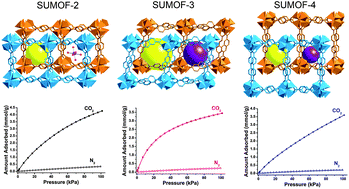Interpenetrated metal–organic frameworks and their uptake of CO2 at relatively low pressures†
Abstract
Adsorption-driven separation of CO2 from flue gas has the potential to cut the cost for carbon capture and storage. Among the porous physisorbents, metal–organic frameworks (MOFs) are a class of promising candidates for gas separation and storage owing to their extraordinarily high specific surface areas and pore volumes, and predesigned pore structures. Here, we report three interpenetrated MOFs composed of Zn4O clusters and rigid dicarboxylate anions, namely SUMOF-n (SU = Stockholm University; n = 2, 3, 4). All the interpenetrated MOFs possess small pores of two different types and high pore volumes. SUMOF-2 had a structure similar to interpenetrated MOF-5, but with an extra-framework

- This article is part of the themed collection: Integrating functionality into metal–organic frameworks

 Please wait while we load your content...
Please wait while we load your content...